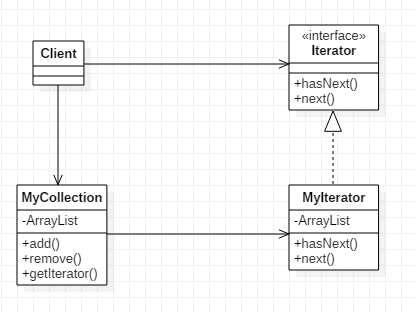設計模式(10)叠代器模式
阿新 • • 發佈:2019-04-02
ali 它的 alt set override getname () mov 價格
叠代器模式提供了一種方法順序訪問一個聚合對象中的各個元素,而又不暴露其內部的表示。

下面我們利用java自帶的叠代器接口實現這個叠代器模式
首先我們定義一個自定義的集合類,並實現它的叠代器
public class Book { public Book(String name, Double price) { this.name = name; this.price = price; } /** * 名稱 */ private String name; /** * 價格*/ private Double price; public String getName() { return name; } public void setName(String name) { this.name = name; } public Double getPrice() { return price; } public void setPrice(Double price) { this.price = price; } }
public class MyCollection { private List<Book> dataList = new ArrayList<>(); public void add(Book data) { dataList.add(data); } public void remove(Book data) { dataList.remove(data); } public MyIterator getIterator() {return new MyIterator(this.dataList); } }
public class MyIterator implements Iterator<Book> { private List<Book> dataList; private int index; public MyIterator(List<Book> dataList) { this.dataList = dataList; index = 0; } @Override public boolean hasNext() { return index < dataList.size(); } @Override public Book next() { return dataList.get(index++); } }
測試
public static void main(String[] args) { MyCollection collection = new MyCollection(); collection.add(new Book("SQL從刪庫到跑路",66.6)); collection.add(new Book("JAVA從入門到放棄",88.8)); MyIterator iterator = collection.getIterator(); while (iterator.hasNext()) { Book book = iterator.next(); System.out.println("書名:"+ book.getName() + ",售價:" + book.getPrice()); } }
結果

設計模式(10)叠代器模式
